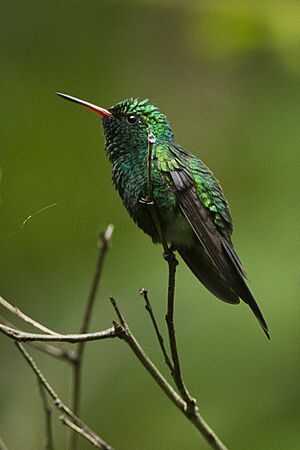Golden-crowned emerald facts for kids
Quick facts for kids Golden-crowned emerald |
|
|---|---|
 |
|
| Conservation status | |
| Scientific classification | |
| Genus: |
Cynanthus
|
| Species: |
auriceps
|
| Synonyms | |
|
Trochilus auriceps; Chlorostilbon auriceps |
|
The golden-crowned emerald (scientific name: Cynanthus auriceps) is a beautiful type of hummingbird. It belongs to a group of hummingbirds called "emeralds." This special bird lives only in western Mexico.
Contents
About the Golden-Crowned Emerald
How Scientists Classify This Bird
Scientists group living things based on how they are related. This is called taxonomy. The golden-crowned emerald was first described in a different group, or genus, called Trochilus. Over time, scientists have changed their minds about where it best fits.
For a while, some thought it was a type of Canivet's emerald. Others even put it with the blue-tailed emerald. But now, many big bird organizations agree. They place it in the Cynanthus genus. This group also includes the broad-billed hummingbird. The golden-crowned emerald is considered a unique species, meaning it does not have different subspecies.
What Does This Hummingbird Look Like?
The golden-crowned emerald is a small bird. It is about 7.5 to 9.5 centimeters (3 to 3.7 inches) long. It weighs around 2.2 grams (0.08 ounces), which is very light!
The adult male has a super shiny, golden-green crown on its head. The rest of its upper body is also golden-green, but a bit duller. Its belly and throat are bright green, turning golden-green near its tail. The male has a long, deeply forked tail. Its tail feathers are black with a pretty violet-blue shine. The tips of the middle tail feathers are brownish-gray. The male's beak is red with a black tip.
The adult female looks similar on her upper body. But her underparts are light gray. Her cheeks are dark, with a whitish streak behind her eye. Her tail is also forked, but much shorter than the male's. The central tail feathers are bluish-green. Most of them have a black band near the end and gray tips. The female's lower beak is red with a black tip, while her upper beak is black.
Where the Golden-Crowned Emerald Lives
Its Home in Mexico
The golden-crowned emerald lives in western Mexico. You can find it from Sinaloa in the north, all the way south to eastern Oaxaca. It also lives inland along the Balsas River basin, reaching southern Morelos.
Preferred Habitat
This hummingbird likes to live in tropical dry forest areas. It can be found from sea level up to about 1,800 meters (5,900 feet) high.
Golden-Crowned Emerald Behavior
Movement and Migration
Most golden-crowned emeralds stay in one place all year. They are considered "resident" birds. However, some might move to different elevations during certain seasons. This means they might fly higher or lower on mountains depending on the time of year.
How They Find Food
The golden-crowned emerald is a "trap-line" feeder. This means it visits a regular path of flowering plants. It flies from one flower to another to drink nectar. Nectar is a sweet liquid that gives the bird energy. While feeding, they often wag their tail and spread its fork. Besides nectar, they also eat small insects they find on leaves.
Reproduction and Life Cycle
The breeding season for the golden-crowned emerald seems to be from February to July. The female builds a small, cup-shaped nest. She usually places it near the end of a thin branch, close to the ground.
Some nests found in Jalisco had a small platform of wood pieces under the cup. The nest cup itself is made from soft kapok seed fibers. Grass, small bits of wood, and lichens are often used on the outside of the nest. The female usually lays two eggs. The young birds leave the nest about 24 or 25 days after they hatch.
Their Calls and Sounds
The golden-crowned emerald makes sounds that are described as "dry, rattling and chattering calls."
Conservation Status
Is This Bird in Danger?
The IUCN (International Union for Conservation of Nature) has looked at the golden-crowned emerald. They have assessed it as being of "Least Concern." This is good news! It means the bird is not currently considered to be in danger of extinction.
This hummingbird has a large area where it lives. Scientists estimate there are at least 50,000 adult birds. Even though the population might be slowly decreasing, human activities probably do not have a big short-term effect on this species.


